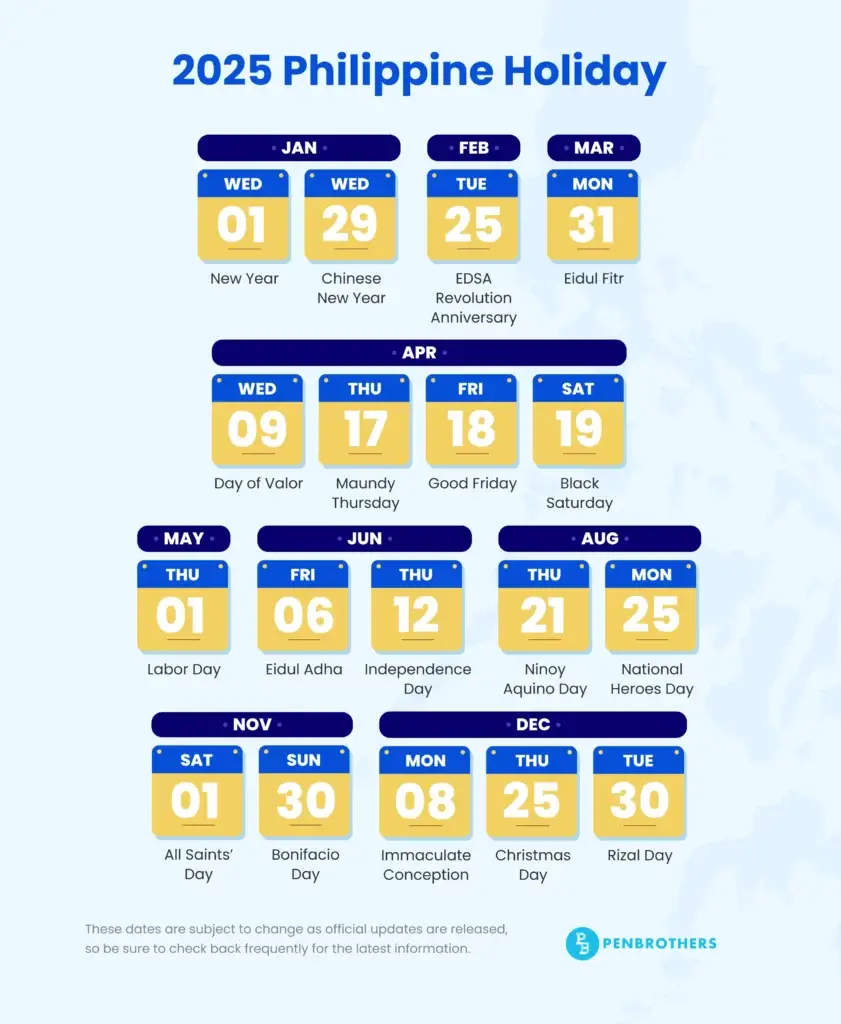What's Inside?
Philippine Holidays 2025: Complete Guide for Remote Team Management

The Google Chat channel was dead.
Sarah refreshed her screen three times. Nothing. Her entire development team (eight talented engineers based in Manila) had vanished. The product launch was in 72 hours. The final API integration wasn’t complete. And now, radio silence.
She checked the time zones again. 9 AM in Manila. Perfect working hours. She pinged Mark, her lead developer. Then Joy from QA. Then the entire team channel with an increasingly urgent “Hey everyone, status update?”
Silence.
It took her another twenty minutes of mild panic before she thought to check the calendar. November 30. Sunday. Seemed normal enough until she remembered something her HR partner had mentioned weeks ago about Philippine holidays.
A quick search confirmed her suspicion: Bonifacio Day. A regular holiday in the Philippines, which meant her entire team was legally entitled to the day off, and if she’d asked them to work, she’d owe them 200% of their daily rate.
Sarah’s not alone. Every day, managers across the US, UK, and Australia discover that managing Filipino remote teams requires more than just scheduling across time zones. It demands understanding a complex holiday system that includes 21 official holidays, intricate compensation rules, and cultural expectations that can make or break team morale.
The disconnect can be severe. While you’re pushing toward Q4 targets, your team might be offline for Undas. When you’re planning that critical December sprint, they’re navigating a potential 9-day holiday stretch. And if you don’t understand the difference between regular and special non-working holidays, you’re already behind.
Here’s what most international companies get wrong about Philippine holidays 2025: they treat them like an HR compliance checkbox instead of a strategic planning opportunity. The companies that thrive with Filipino talent? They understand that these 21 days aren’t obstacles. They’re a framework for building trust, optimizing productivity, and creating competitive advantage.
This guide breaks down everything you need to master Philippine holidays 2025, from the official Proclamation 727 calendar to compensation formulas that actually make sense, from managing those 11 long weekends to building policies that keep your team engaged and your projects on track.
Let’s make sure you’re ready.
Key Takeaways
- A Complex, Legally Mandated System: The Philippines operates on a complex system of 21 official holidays categorized as either Regular Holidays (200% pay rate if worked) or Special Non-Working Holidays (130% pay rate if worked). Understanding this distinction is essential for compliance and avoiding costly payroll errors.
- The December Mega-Break is the Highest Risk: The highest-risk period for global operations is the extended year-end break, which can combine three Regular Holidays and three Special Non-Working Days to create a potential 9-day operational shutdown (December 24 to January 1). Proactive planning must begin in Q3 (September/October) to mitigate this.
- The Strategic Value of the “No Work, No Pay” Holidays: Special Non-Working Holidays operate on a “no work, no pay” basis. Smart managers can use a “Goodwill Play” by selectively granting these days as paid time off, which costs a fraction of an employee’s annual salary but significantly boosts morale and long-term loyalty.
- Compensation Can Stack Up to 260%: Overtime premiums stack on top of the holiday pay rate. Working beyond eight hours on a Regular Holiday can push the compensation rate to 260% of the employee’s regular hourly wage, making accurate payroll automation critical to avoid high costs and legal liability.

The True Cost of Holiday Misalignment (Beyond the Overtime Pay)
Yes, the overtime calculations matter. Working on a special non-working holiday triggers a 130% rate. Regular holidays demand 200%. Work past eight hours on any holiday, and you’re stacking premiums that can push costs to 260% of base pay.
But let’s examine the hidden costs that don’t show up in payroll reports:
Project Momentum Loss: Every unexpected holiday creates a stop-start dynamic that kills productivity momentum. Your team loses context. Handoffs become messy. What should take three days stretches to a week.
Client Confidence Erosion: Nothing damages client relationships faster than missed deadlines you can’t explain. “My team was off for Bonifacio Day” doesn’t resonate with a CEO in London who’s never heard of Andrés Bonifacio.
Team Morale Complexity: Force your team to work through their holidays, even with premium pay, and you’re trading short-term coverage for long-term loyalty. Filipino culture places profound importance on these observances. Miss that, and you’ve missed everything.
Communication Compound Effect: Holiday weeks create communication black holes. Questions pile up. Decisions stall. By the time your team returns, you’re not managing work, you’re managing backlog.
What Proclamation 727 Means for Your 2025 Planning
On October 30, 2024, President Ferdinand Marcos Jr. signed Proclamation No. 727, officially declaring the regular and special non-working holidays for 2025. This isn’t just government paperwork. It’s your operational roadmap.
In essence, Proclamation 727 gives you 21 days that require strategic planning:
- 12 regular holidays where your team is legally entitled to a day off with pay
- 9 special non-working holidays following “no work, no pay” rules (unless you’ve negotiated otherwise)
But here’s what matters for remote management: This proclamation enables you to plan with precision.
Take the December 2025 stretch: potentially nine consecutive days from December 24 to January 1, 2026. Knowing this, you can communicate it to clients in October and then arrange coverage swaps with teams in other regions.
Your 2025 Philippine Holiday Playbook
According to Proclamation No. 727, you’re navigating 21 official holidays in 2025. But not all holidays are created equal, especially when you’re managing from halfway around the world.
Each holiday carries different signals, different risks, different opportunities.
12 Regular Holidays
These are your non-negotiables. Under the Labor Code of the Philippines, your team is entitled to these days off with full pay. Need them to work? That’s 200% of their daily rate for the first eight hours, plus overtime premiums if you push beyond that.
| Date | Day | Holiday | Remote Impact | Common Client Conflicts | Coverage Strategy |
|---|---|---|---|---|---|
| Jan 1 | Wed | New Year’s Day | HIGH | Global holiday alignment helps, but many push Q1 starts | Arrange December handoffs; set client expectations early |
| Mar 31 | Mon | Eid’l Fitr* | MEDIUM | Western clients unfamiliar; falls on regular workday | Communicate dates once confirmed; plan async work |
| Apr 9 | Wed | Araw ng Kagitingan | MEDIUM | Mid-week disruption; Western clients in full swing | Schedule critical meetings Tue/Thu; batch async tasks |
| Apr 17 | Thu | Maundy Thursday | HIGH | Major Western holiday overlap; 4-day weekend impact | Align with Western observance; minimal conflict |
| Apr 18 | Fri | Good Friday | HIGH | Global Christian observance provides cover | Natural alignment; focus on documentation |
| May 1 | Thu | Labor Day | LOW | Partial global observance; creates 4-day weekend | Many countries observe; easier to explain |
| Jun 6 | Fri | Eid’l Adha* | MEDIUM | Creates 3-day weekend; unfamiliar to Western clients | Early communication essential; async project focus |
| Jun 12 | Thu | Independence Day | HIGH | Mid-June deliverables at risk; 4-day weekend potential | Heavy pre-planning; consider Wed handoffs |
| Aug 25 | Mon | National Heroes Day | MEDIUM | Monday holiday = long weekend; August vacation overlap | Plan for Friday completions; Monday coverage from other regions |
| Nov 30 | Sun | Bonifacio Day | LOW | Falls on Sunday; minimal disruption | Natural weekend; no special planning needed |
| Dec 25 | Thu | Christmas Day | LOW | Global holiday; universal understanding | Natural alignment with Western clients |
| Dec 30 | Tue | Rizal Day | HIGH | Year-end crunch; part of mega-break | Plan November handoffs; skeleton crew only |
9 Special Non-Working Holidays
These ones follow “no work, no pay” rules, unless you’ve negotiated otherwise. But if you need coverage, you’re looking at 130% of daily wages, plus overtime if applicable.
The most culturally sensitive period is Undas. While All Saints’ Day (November 1) is the only official holiday, many Filipinos will take leave on the preceding Friday, October 31, to travel to their home provinces. Prudent managers should plan for a significant slowdown starting that Friday.
| Date | Day | Holiday | Remote Impact | Pay Implications | Alternative Scheduling |
|---|---|---|---|---|---|
| Jan 29 | Wed | Chinese New Year | LOW | 130% if working; consider cultural significance for Chinese-Filipino staff | Voluntary basis; async work options |
| Apr 19 | Sat | Black Saturday | LOW | Weekend rate + 130%; part of 4-day Holy Week | Minimal need; emergency only |
| Aug 21 | Thu | Ninoy Aquino Day | MEDIUM | Creates 5-day break with strategic leave; 130% rate | Batch deliverables early week |
| Nov 1 | Sat | All Saints’ Day | HIGH | Weekend rate + 130%; peak of Undas observance | Emergency coverage only; deeply cultural |
| Dec 8 | Mon | Immaculate Conception | MEDIUM | Creates 3-day weekend; December crunch time | Consider voluntary overtime pool |
| Dec 24 | Wed | Christmas Eve | HIGH | Starts 9-day mega-break; 130% + holiday spirit | Skeleton crew; voluntary basis only |
| Dec 31 | Wed | Last Day of Year | HIGH | Part of mega-break; global celebration | Minimal operations; emergency only |
The Variables
Election Day (May 12, 2025)
Special non-working holiday per Proclamation No. 878. Here’s what makes election days unique:
- Total focus shift: Your team’s mind is on civic duty, not sprints
- Infrastructure impact: Internet cafes close; power interruptions possible
- Travel complications: Team members often return to home provinces to vote
- Coverage reality: Even with 130% pay, availability is limited
Strategic play: Block May 12-13 for low-priority work. Plan major deliverables for the following week.
Islamic Holidays
The National Commission on Muslim Filipinos (NCMF) typically announces final dates closer to the occasion. Based on lunar calculations:
- Eid’l Fitr: Provisionally March 31, 2025
- Eid’l Adha: Provisionally June 6, 2025
The challenge: These dates can shift by 1-2 days based on moon sighting. Your Q2 planning needs buffer zones around both dates.
Smart approach:
- Block the provisional dates plus one day either side
- Communicate uncertainty to clients early
- Plan flexible deliverables that week
- Keep Muslim team members in the loop for earliest confirmation
Now that your playbook is set, let’s talk about money.
Remote Team Compensation: Getting the Math Right
Regular Holiday Economics
The baseline is deceptively simple.
Remote Worker Not Scheduled: The 100% Pay Reality
Your developer isn’t working on Christmas Day (December 25, 2025). Under Article 94 of the Labor Code, you still pay them 100% of their daily rate, provided they worked or were on paid leave the day before the holiday. No work, full pay. That’s the law.
Emergency Coverage Needs: The 200% Calculation
Now the math gets interesting.
Your client’s system crashes on Independence Day (June 12, 2025). You need your senior engineer online. Here’s what that costs:
Basic Formula (First 8 Hours):
- Daily Rate × 200% = Holiday Pay
- ₱2,000 daily rate × 200% = ₱4,000
But that’s just the beginning.
The Overtime Domino Effect
Work past eight hours on a holiday? The premiums stack:
Regular Holiday Overtime Formula:
- Work exceeding eight hours on a Regular Holiday is compensated with an additional 30% of the hourly rate on that day.
- Overtime Rate Per Hour: (Hourly Rate × 200%) × 130%. This simplifies the rate to 260% of the employee’s regular hourly wage.
Sample scenario: Your developer works 10 hours on Good Friday fixing critical bugs.
- Regular 8 hours: ₱2,000 × 200% = ₱4,000
- Overtime 2 hours: (₱250/hour × 200%) × 130% = ₱1,300
- Total cost: ₱5,300 (vs. ₱2,000 normal day)
Special Holiday Decisions
Special non-working holidays operate on a different logic. The baseline is ‘no work, no pay.’ But what happens when they do work?
When to Pay vs. When to Flex
You have options with special holidays. The Labor Code doesn’t mandate pay, but smart companies create policies that build trust.
Scenario 1 (The Goodwill Play): Company A gives their team All Saints’ Day (November 1, 2025) off with pay, even though it’s not required. Cost: One day’s wages. Return: Loyalty during a deeply cultural observance.
Scenario 2 (The Flexibility Framework): Company B offers a choice: Work on Chinese New Year (January 29, 2025) for 130% pay, or take unpaid leave and make up hours async. Result: Team members choose based on personal needs.
Scenario 3 (The Strategic Swap): Company C treats special holidays as floating days. Team members can work the holiday and take a different day off. This maintains coverage while respecting individual preferences.
Building Goodwill Without Breaking Budgets
Here’s a framework that’s worked for many companies:
The 50/50 Approach: Pay 50% of daily rate for special holidays even when not working. It’s not required, but it demonstrates cultural awareness without full cost impact.
The Performance Link: Tie special holiday pay to performance metrics. Hit team targets? Special holidays become paid. This aligns incentives while managing costs.
The Culture Investment: Choose 2-3 culturally significant special holidays (like Undas) and make them paid. The selective approach shows you understand what matters most.
The Hidden ROI of Holiday Pay Policies
Let’s talk real numbers.
According to multiple online job portals and industry reports, the average monthly salary for a skilled Filipino remote professional often falls within the $800-$1,500 range. The 9 special holidays represent potential cost of:
- Option A (Unpaid): $0 additional cost
- Option B (50% pay): $150-280 annual investment
- Option C (Full pay): $300-560 annual investment
Now consider replacement costs:
- Recruiting: 2-3 months salary
- Training: 1-2 months productivity loss
- Cultural reset: Immeasurable
A generous holiday policy that costs $500 annually prevents turnover that costs $5,000.
But the real ROI isn’t measurable in dollars. It’s in the developer who stays late to fix your critical bug because you respected their need for Undas leave. It’s in the account manager who handles that difficult client because you didn’t nickel-and-dime their holiday pay.
So yes, the formulas matter. The Labor Code requirements are non-negotiable. But the strategic decisions around special holidays? That’s where you differentiate between vendors who provide bodies and partners who build teams.
Now let’s talk about the many long weekends of 2025 and how to turn them from disruptions into advantages. With at least five official long weekends and several more possible by bridging a single workday, strategic planning is key.
Maximizing the 2025 Long Weekends: A Strategic Guide for Remote Teams
Long weekends in the Philippines aren’t just extended breaks. They’re cultural moments, family obligations, and operational puzzles that require different thinking than your typical three-day weekend in Denver or Dublin.
We’re guaranteed at least five official long weekends in 2025, where holidays naturally fall on Mondays or Fridays. Add the potential Islamic holidays and the Filipino tradition of ‘bridging’ single vacation days, and you’re looking at multiple extended breaks that can either derail your operations or become strategic advantages.
So let’s build frameworks for the three patterns that matter most.
High-Impact Periods for Remote Teams
1. The December-January Stretch (Up to 9 Days)
This is the big one.
Starting December 24 (Christmas Eve) through January 1 (New Year’s Day), you’re navigating a potential 9-day absence if your team takes just two strategic leave days. Most will.
Client Communication Templates:
It’s best to start these conversations in October. Not December. October. Here’s the framework that works:
Early October Email: “As we plan Q4 deliverables, I want to highlight that our Philippine team observes extended holidays from December 24-January 1. We’re implementing coverage plans now to ensure seamless service. Can we schedule a brief call to align on critical deadlines?”
November Reminder: “Following up on our October discussion, we’ve arranged coverage for December 24-January 1. Here’s our skeleton crew schedule and escalation protocol. All major deliverables will be completed by December 20.”
December 15 Final Notice: “Reminder: Our Philippine team’s holiday schedule begins December 24. Your designated contacts during this period are [names]. For urgent matters, use [escalation process].”
Skeleton Crew Planning:
The 30% Rule: Aim for 30% voluntary coverage. More creates resentment. Less leaves gaps.
The Regional Swap: Partner with teams in regions that don’t observe these holidays. Australian teams can cover Asian clients. European teams handle US morning shifts.
The Premium Pool: Create a volunteer pool with premium incentives. Not just holiday pay, but additional time off in January or performance bonuses.
Handoff Protocols:
The best handoff happens in November, not December. Here’s the systematic approach:
- November 15-20: Identify all ongoing projects requiring December attention
- November 25-30: Create detailed handoff documentation
- December 1-10: Conduct handoff meetings with coverage teams
- December 15-20: Final reviews and contingency planning
- December 23: All handoffs complete, documentation accessible
2. Holy Week (4 Days)
Holy Week presents unique dynamics. While Western clients often observe Good Friday, the Philippine observance is deeper, more comprehensive.
Western observance typically includes:
- Good Friday (partial or full holiday)
- Easter Monday (in some countries)
Philippine observance includes:
- Maundy Thursday (April 17)
- Good Friday (April 18)
- Black Saturday (April 19)
- Cultural expectation of Easter Sunday celebration
Coverage Strategies That Work:
The Alignment Play: Frame it as mutual respect. “We observe your Thanksgiving; you observe our Holy Week.” This repositions the break from inconvenience to cultural exchange.
The Documentation Sprint: Holy Week becomes documentation week. No client calls, no urgent deliveries. Teams focus on knowledge transfer, process documentation, and async work.
The Rotation System: Split teams into two groups. Group A takes Thursday-Friday, Group B takes Saturday-Monday. Maintains 50% coverage while respecting observance.
3. Strategic Singles (May, June, August)
These are your optimization opportunities. Single holidays that create 4-day weekends with one strategic leave day.
May 1 (Labor Day – Thursday). Creates 4-day weekend with Friday leave. The opportunity: Most global companies partially observe Labor Day. Use this alignment.
June 12 (Independence Day – Thursday). Another Thursday holiday. The pattern is clear. Smart teams batch all Friday deliverables for Thursday completion.
August 21-25 (Ninoy Aquino Day to National Heroes Day). This is the sleeper stretch. With one strategic Friday leave, your team gets five consecutive days. Most international clients don’t know these holidays exist.
The DOLE doesn’t mandate bridge leaves, but Filipino culture embraces them. Understanding this helps you plan:
The Preemptive Approach: “We noticed June 12 falls on Thursday. Would your team prefer to bridge Friday for a long weekend? We can adjust deadlines accordingly.”
The Trade System: Offer bridge days in exchange for coverage during other periods. “Take Friday after Independence Day, cover two hours on the Saturday before.”
Here’s another thing I’ve discovered that could be helpful: Long weekends can increase productivity if you plan for them.
The Sprint Compression: Knowing a 4-day weekend approaches, teams often deliver more in the shortened week. Set ambitious but achievable three-day targets.
The Rest Dividend: Well-rested teams perform better. That 4-day break in May powers stronger output through June.
The Cultural Capital: Respecting these breaks builds loyalty that translates to discretionary effort when you need it most.
So yes, Philippine holidays 2025 include multiple long weekends that could disrupt your operations. Or they could become the rhythm that makes your remote team more effective than your local one.
The companies that thrive don’t fight this calendar. They dance with it.
The Four Most Critical Holiday Disruptions for Remote Teams
To effectively plan project timelines and client expectations, remote managers must focus their attention on the four periods that cause the highest combined disruption, due to legal mandates, cultural significance, and the potential for long weekend stacking.
1. The Christmas & New Year Mega-Break (Dec 24 – Jan 1)
This period is the Highest Risk zone. It combines three Regular Holidays (Christmas Day, Rizal Day, New Year’s Day) and three Special Non-Working Days (Christmas Eve, Last Day of Year, New Year’s Eve), creating a high likelihood of a 9-day operational shutdown. Planning for zero availability from December 24 to January 2 is the only prudent move.
2. Holy Week (Semana Santa) (Maundy Thursday – Black Saturday)
Holy Week (April 17–19) is the most Culturally Sensitive break. As a predominantly Catholic country, most businesses and employees prioritize reflection and family travel. While only Maundy Thursday and Good Friday are Regular Holidays, Black Saturday is a Special Non-Working Day, creating a guaranteed 4-day weekend where availability is nearly impossible to secure, even with high premium pay.
3. Undas (All Saints’ Day) (October 31 – November 1)
The Travel & Leave Risk zone. While only All Saints’ Day (November 1) is a holiday (Special Non-Working), the Proclamation added October 31 (All Saints’ Day Eve) as an Additional Special Non-Working Day to promote family ties. This creates a powerful 3-day long weekend, driving massive internal migration as Filipinos return to their home provinces. Expect operational slowdowns starting the preceding Thursday.
4. August/September Mid-Year Cluster
The Strategic Leave Risk zone. Two holidays—Ninoy Aquino Day (August 21, Special Non-Working) and National Heroes Day (August 25, Regular Holiday, always a Monday)—are strategically placed. Employees often take just one day of leave (Friday, August 22) to create a highly disruptive 5-day break. Managers must proactively address this bridging opportunity to manage client deliverables.
How Strategic Staffing Partners Manage Holiday Disruptions
For international companies, successfully navigating 21+ holidays requires systems that transcend a simple calendar. This is the operational advantage that strategic staffing partners, rather than pure recruitment agencies, deliver.
Proactive Planning and Mitigation
A strategic partner like Penbrothers embeds holiday planning into the Hypercare Framework—the 180-day program designed to accelerate productivity and retention.
- Q4 Client Alignment: By Q3 (September/October), a partner ensures the client’s internal team has signed off on the December mega-break strategy, preventing the kind of last-minute panic described at the start of this article.
- Contingency & Coverage: For critical roles (like the developer in the article), the partner builds clear coverage protocols using tiered premium pay for voluntary work, ensuring skeleton crew coverage without forcing participation.
Compensation Compliance and Goodwill
The legal risk of miscalculating holiday pay (which can reach 260% of base pay for overtime on a Regular Holiday falling on a rest day) is fully absorbed by the partner.
- Accurate Payroll: Ensures 100% adherence to DOLE Labor Advisories and Proclamations, eliminating legal liability and administrative risk for the client.
- Cultural Investment: A strategic partner advises clients on the high ROI of the “Goodwill Play”—selectively making culturally significant Special Non-Working Days (like All Saints’ Day Eve) paid, which costs a fraction of the recruitment and training expense of replacing a loyal employee.
Effective holiday management is not just about compliance; it is a retention tool, and the core of the strategic advantage provided by managed offshore teams.
Your Next Move
So, where do you go from here?
You’ve got the calendar. You understand the compensation frameworks. You see the strategic possibilities in those long weekends.
The question is implementation. How do you transform this knowledge into operational excellence? How do you build the systems that turn holiday management into a competitive advantage?
That’s where the real work begins. And honestly? Most companies need help navigating this transition. The stakes are too high, and the cultural nuances too important to leave to chance.
If you’re serious about building world-class Filipino remote teams, the kind that become true partners in your growth, let’s talk about what that looks like for your specific situation.
Because managing Philippine holidays effectively isn’t just about marking calendars. It’s about building the foundation for remote team excellence that compounds for years.
The companies that figure this out don’t just save on talent costs. They build unstoppable global operations.
Ready to build your strategic advantage? Let’s explore how Penbrothers can help you master remote team excellence.
Frequently Asked Questions
Regular Holidays (like New Year’s Day and Christmas Day) are legally mandatory days off with full pay (100%), even if the employee does not work. If the employee is required to work, they must be paid 200% of their daily rate. Special Non-Working Holidays (like Ninoy Aquino Day) follow a “no work, no pay” rule, but if the employee is asked to work, they are paid only 130% of their daily rate.
The best practice is to plan for zero availability from approximately December 24 through January 1. Managers should communicate this schedule to clients in October, execute a systematic handoff of all critical projects by mid-December, and set up a skeleton crew of voluntary workers with premium incentives for emergency coverage.
For the first eight hours worked on a Regular Holiday, the employee must be paid 200% (double pay) of their regular daily rate. If the employee works overtime (past eight hours) on that holiday, the rate increases to 260% of their regular hourly wage.
Undas (November 1) is a critical, deeply cultural observance that involves massive internal migration as Filipinos return to their home provinces. Prudent managers should anticipate a significant slowdown starting on the preceding Friday (October 31) and ensure project deliverables are not scheduled for that weekend.
A manager can use these holidays for a “Goodwill Play.” Since these days are legally “no work, no pay,” the company can choose to grant the day off with full pay, even though it’s not mandated. This low-cost investment in goodwill and cultural respect is highly valued by employees and contributes to long-term retention.




